

A group of young architects in Tucson is studying desert plants and the positioning of primitive dwellings to create new techniques in environmental architecture for hot climates. They are part of a school known as Emerging Material Technologies. In Arizona they are represented by Binary Design, founded by Dale Clifford and Jason Vollen, former professors at the University of Arizona School of Architecture.
By Thomas Whittingslow
Binary Design is founded on Aristotle’s theory of “praxis[1],” where theoretical knowledge is manifest as practical, hands-on solutions. Through careful observation of programmed natural forces, Binary takes the theoretical or abstract data that emerges from a particular location or building site, and then develops it into a unique kind of architecture that is both sustainable and practical. Binary has created a new genre of Green building for hot desert climates by turning conventional models of architecture inside out.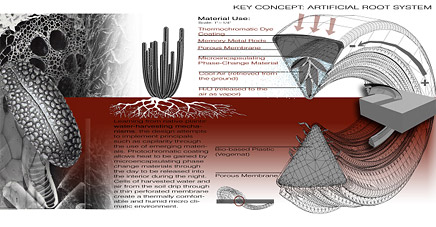
The cooling blocks being manufactured by Binary Design and Emerging Materials Technology mimic the capillary system and porous membrane of native desert plants’ water-harvesting mechanisms. Researched by Matan Mayer.
Their first speculative home called “Mariposa de Acero,” or Steel Butterfly is located on a hillside south of Tucson and will be placed on the market in early 2009. Clifford and Vollen act as architects and work closely with Todd Wilson, the innovative developer and builder of Steel Butterfly. This working relationship is essential to ensure quality design at relatively low cost. By taking binary patterns which they learned from the hillside, then applying them to practical solutions, Vollen and Clifford have come up with some revolutionary ideas. In order to keep disruption of the soil to an absolute minimum the entire structure is mounted on bridgework of steel struts. Cool air comes down from the mountain in the evening then it is “pulled” through the building by an open courtyard that separates the two major elements of the house. This application is based on studies of primitive dwellings sites that were created by the Hohokam who separated family modules by breezeways. Learning from the water-harvesting mechanisms of native plants photo-chromatic coatings , the exterior courtyard surface of the Mariposa home is lined with “passive” cooling blocks, utilizing the same membrane/capillary principles, found in barrel cactus e.g. water trickles down the blocks and draws cool air into the house, similar in principle to an evaporative cooler.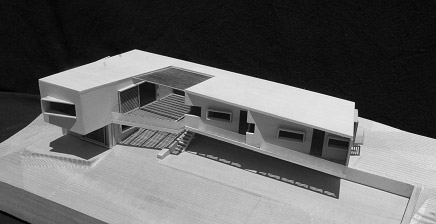
Model of Clifford and Vollen’s “Mariposa de Acero” or steel butterfly residence south of Tucson is perched lightly on a delicate desert hillside and takes advantage of passing and cooling thermal flows along the mountainside. Design assistance: Eddie Hall.
Currently, Vollen and Clifford are involved with Carnegie Mellon University and the Rensselear Polytechnic Institute — pursuing advanced analysis, modeling and testing emerging materials for greater physical efficiencies in home construction. As part of that ongoing process, they are producing ceramic blocks, based on the thermodynamic strategies of barrel cacti and termite mounds. In keeping with Binary’s philosophy of learning through work, Vollen and Clifford will manufacture the blocks themselves. They hope that these materials will soon be available in new homes.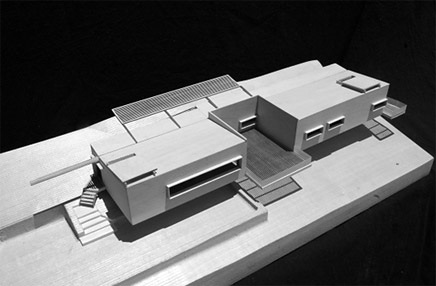
Scale model: “Wilson Residence,” or Steel Butterfly is perched lightly on a delicate hillside south of Tucson. By elevating the house on a system of steel girders, disruption of the land was kept to an absolute minimum. Its careful orientation takes advantage of passive heating and cooling thermal flows along the mountainside.
“Contemporary housing strategies in southern Arizona satisfy LEED standards with high insulation and tight construction. The premise is that a highly insulated, tight house will take less energy to mechanically condition,” said Clifford. Binary Design looks to surpass LEED Green Building Council certification, the current standard for the industry. “Our approach is quite different: depending upon a combination of vernacular and high tech strategies that engage a specific site, we might open the house up and bring the outside in, resulting in a home that is sensitive to the changing environment of that particular location, such as we did with the Steel Butterfly. It’s a different way of living. As much as possible, we’re using passive principles like natural ventilation, orientation and overhangs, augmented with the technology and materials that make the building more efficient. As you learn to live in this house, your energy bills will go down. Without a doubt, the same principles could work on production housing. At the outset, the builder would have to pay more attention to orientation, which would get away from monotonous siting, typical of PUD’S.”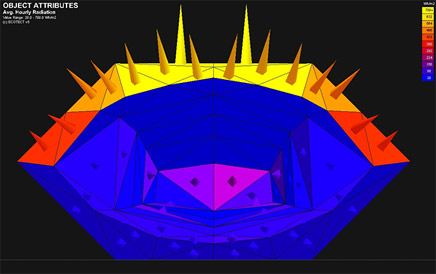
Ecotect solar insulation analysis of a new concrete block developed by M. Gindlesparger, Research Principal at Binary. The block is geometrically tuned to admit solar radiation in the winter months and shade itself in the summer. The block is not dissimilar in function to the human eyebrow. This is how the thermal block appears in the month of May.
Thermal block in November.
Clifford and Vollen not only want to impact the architectural design community, but also to change how we think about living in our homes. Vollen offered some “binary” advice on green construction to local home builders: “The best thing that Arizona builders and developers could do is avoid building with 2x4 lumbers in a place where there are no trees. We are in an area where historically lots of masonry and ceramic products have been produced, but we don’t seem to be taking advantage of that. Perhaps by training new entry-level people in the trades, we could regain some of that skill. It could be 30 to 40 percent cheaper if we build with masonry rather than wood, or a combination of wood and stucco.” Clifford went on to explain that stucco was originally designed to be applied on top of masonry products — not wood.
When discussing ways to save energy, Clifford made some surprising observations: “One thing we notice in stucco production houses is that the openings were designed for locations like Tallahassee or Chattanooga, not the Desert Southwest. By taking more time to manipulate these openings and tune them to the environment, you could have a much better house and achieve significant energy savings. If you have the right view and make the right arrangement, the value of the home is increased both aesthetically and financially.”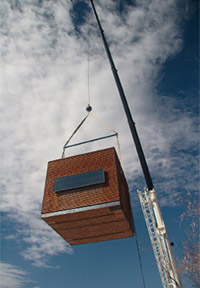
This pod was constructed at Binary’s shop in Tucson, then delivered to the site. Its size makes it ideal for a home office or studio add on in established neighborhoods. (Photo: David Olsen)
The demand for sustainability is not just a builder or homeowner issue but it dictates the core values of half of the world’s 500 largest companies, which say they want to build and occupy real estate that reflects their values, while others are still struggling to define it. To major builders like Pulte and US Homes it is often part of a marketing campaign aimed at “Green” concision buyers, based on the LEED scale. To others, like Al Gore and William McDonough, it has become a moral or political issue. For a snapshot of how big the sustainable vision is, the Brookings Institute says that half of the buildings that we will live in by 2030 don’t even exist today. This translates into a $25-trillion building boom—an opportunity so enormous that the building industry could literally change the face of how and where we live. Nowhere will this be more evident than in the Desert Southwest.
Acknowledging the social contract of architects to serve those in need, Binary has also created small SEED (pods) as an alternative form of affordable dwelling for that segment of the global market that cannot qualify for a traditional home. Essentially is the smallest liveable module that that be added to as the situation or need arises. It is also applicable for those who want to add additional living space at minimal cost while maintaining sensitivity to aesthetics and sustainability. Examples of this for SEED (pod) installations can be seen in Tucson, Arizona.
As the seedpod protects and nourishes the seed in the initial stages, the SEED (pod) provides and alternative form of equity building. The continuing rising of construction costs keeps starter homes out of reach for percentage of the market. A new model for home buying is desperately needed . With Binary’s SEED (pod) the first time buyer can get into the market with the smallest livable unit, adding to the house when necessary. With a low purchase price, low square footage, the SEED (pod) can be added to in affordable increments. (Photo: David Olsen)
Vollen is a graduate of Cranbrook Academy, a preeminent graduate school in design and architecture. Other graduates such as Carl Milles, Harry Bertoia, Charles and Ray Eames, Florence Knoll and Daniel Libeskind have had a major impact on the architecture of our time. Someday, perhaps Vollen and Clifford will join that list.
[1]Praxis: (Greek): the practical application of something, as opposed to theory.
Dale Clifford:
Dale is a principal in Binary Design and a cofounder of the Emerging Materials Technology Research Group at the University of Arizona. Prior to joining the UA faculty, Clifford was an Adjunct Professor the Boston Architectural Center and Portland State University. After completing his professional degree, Clifford worked with Molecular Geodesics, Inc., in Boston, a firm that designed surgical implants and instruments based on biomimetic principles. Clifford is a graduate of the Pratt Institute and the Massachusetts Institute of Technology. He will soon join the faculty o architecture atf Carnegie Mellon University in Pittsburgh, PA.
Jason Vollen:
Jason is an Associate Professor at Rensselaer Polytechnic Institute (RPI) and researcher at CASE, the Center for Architecture Science and Ecology. He is a cofounder of Binary Design and the Emerging Material Technologies Research Group the University of Arizona. Prior to joining RPI and CASE, Vollen worked as an Assistant Professor at The University of Arizona School of Architecture, with Matter Practice in New York and as a fabricator with the Cranbrook Architecture Office. Vollen is a graduate of The Cooper Union and Cranbrook Academy of Art.
Thomas Whittingslow:
Tom is an award winning freelance writer who lives in Tucson, Arizona. His stories on travel, art and architecture have been published in numerous national and international publications.
2 Comments
"...they are producing ceramic blocks, based on the thermodynamic strategies of barrel cacti and termite mounds"
That sounds really interesting - Would love to see what it really looks like
woooo, congrads. hope you like to see it in nyc, jason.
Block this user
Are you sure you want to block this user and hide all related comments throughout the site?
Archinect
This is your first comment on Archinect. Your comment will be visible once approved.